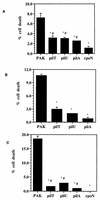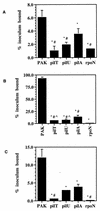Pseudomonas aeruginosa gene products PilT and PilU are required for cytotoxicity in vitro and virulence in a mouse model of acute pneumonia
- PMID: 10377148
- PMCID: PMC116553
- DOI: 10.1128/IAI.67.7.3625-3630.1999
Pseudomonas aeruginosa gene products PilT and PilU are required for cytotoxicity in vitro and virulence in a mouse model of acute pneumonia
Abstract
Type IV pili of the opportunistic pathogen Pseudomonas aeruginosa mediate twitching motility and act as receptors for bacteriophage infection. They are also important bacterial adhesins, and nonpiliated mutants of P. aeruginosa have been shown to cause less epithelial cell damage in vitro and have decreased virulence in animal models. This finding raises the question as to whether the reduction in cytotoxicity and virulence of nonpiliated P. aeruginosa mutants are primarily due to defects in cell adhesion or loss of twitching motility, or both. This work describes the role of PilT and PilU, putative nucleotide-binding proteins involved in pili function, in mediating epithelial cell injury in vitro and virulence in vivo. Mutants of pilT and pilU retain surface pili but have lost twitching motility. In three different epithelial cell lines, pilT or pilU mutants of the strain PAK caused less cytotoxicity than the wild-type strain but more than isogenic, nonpiliated pilA or rpoN mutants. The pilT and pilU mutants also showed reduced association with these same epithelial cell lines compared both to the wild type, and surprisingly, to a pilA mutant. In a mouse model of acute pneumonia, the pilT and pilU mutants showed decreased colonization of the liver but not of the lung relative to the parental strain, though they exhibited no change in the ability to cause mortality. These results demonstrate that pilus function mediated by PilT and PilU is required for in vitro adherence and cytotoxicity toward epithelial cells and is important in virulence in vivo.
Figures



Similar articles
-
Twitching motility contributes to the role of pili in corneal infection caused by Pseudomonas aeruginosa.Infect Immun. 2003 Sep;71(9):5389-93. doi: 10.1128/IAI.71.9.5389-5393.2003. Infect Immun. 2003. PMID: 12933890 Free PMC article.
-
Characterization of a gene, pilU, required for twitching motility but not phage sensitivity in Pseudomonas aeruginosa.Mol Microbiol. 1994 Sep;13(6):1079-91. doi: 10.1111/j.1365-2958.1994.tb00499.x. Mol Microbiol. 1994. PMID: 7854122
-
The pilT gene contributes to type III ExoS effector injection into epithelial cells in Pseudomonas aeruginosa.J Infect Chemother. 2016 Apr;22(4):216-20. doi: 10.1016/j.jiac.2015.12.012. Epub 2016 Jan 23. J Infect Chemother. 2016. PMID: 26809217
-
Adhesins and receptors of Pseudomonas aeruginosa associated with infection of the respiratory tract.Microb Pathog. 1992 Oct;13(4):251-60. doi: 10.1016/0882-4010(92)90035-m. Microb Pathog. 1992. PMID: 1363702 Review.
-
The type-4 pilus is the major virulence-associated adhesin of Pseudomonas aeruginosa--a review.Gene. 1997 Jun 11;192(1):99-108. doi: 10.1016/s0378-1119(97)00116-9. Gene. 1997. PMID: 9224879 Review.
Cited by
-
Effector ExoU from the type III secretion system is an important modulator of gene expression in lung epithelial cells in response to Pseudomonas aeruginosa infection.Infect Immun. 2003 Oct;71(10):6035-44. doi: 10.1128/IAI.71.10.6035-6044.2003. Infect Immun. 2003. PMID: 14500525 Free PMC article.
-
Pseudomonas aeruginosa type IV minor pilins and PilY1 regulate virulence by modulating FimS-AlgR activity.PLoS Pathog. 2018 May 18;14(5):e1007074. doi: 10.1371/journal.ppat.1007074. eCollection 2018 May. PLoS Pathog. 2018. PMID: 29775484 Free PMC article.
-
Building permits-control of type IV pilus assembly by PilB and its cofactors.J Bacteriol. 2024 Dec 19;206(12):e0035924. doi: 10.1128/jb.00359-24. Epub 2024 Nov 7. J Bacteriol. 2024. PMID: 39508682 Free PMC article. Review.
-
The Xanthomonas oryzae pv. oryzae PilZ Domain Proteins Function Differentially in Cyclic di-GMP Binding and Regulation of Virulence and Motility.Appl Environ Microbiol. 2015 Jul;81(13):4358-67. doi: 10.1128/AEM.04044-14. Epub 2015 Apr 24. Appl Environ Microbiol. 2015. PMID: 25911481 Free PMC article.
-
The N. gonorrhoeae type IV pilus stimulates mechanosensitive pathways and cytoprotection through a pilT-dependent mechanism.PLoS Biol. 2005 Apr;3(4):e100. doi: 10.1371/journal.pbio.0030100. Epub 2005 Mar 22. PLoS Biol. 2005. PMID: 15769184 Free PMC article.
References
-
- Alm R, Mattick J S. Genes involved in the biogenesis and function of type-4 fimbriae in Pseudomonas aeruginosa. Gene. 1997;192:89–98. - PubMed
-
- Barnett T C, Kirov S M, Strom M S, Sanderson K. Aeromonas spp. possess at least two distinct type IV pilus families. Microb Pathog. 1997;23:241–247. - PubMed
-
- Bieber D, Ramer S W, Wu C Y, Murray W J, Tobe T, Fernandez R, Schoolnik G K. Type IV pili, transient bacterial aggregates, and virulence of enteropathogenic Escherichia coli. Science. 1998;280:2114–2118. - PubMed
Publication types
MeSH terms
Substances
Grants and funding
LinkOut - more resources
Full Text Sources
Other Literature Sources
Molecular Biology Databases

